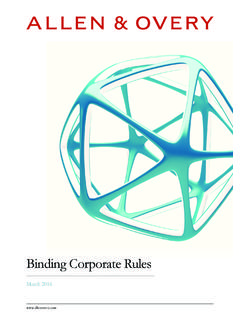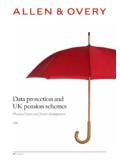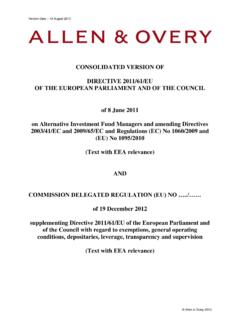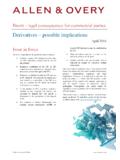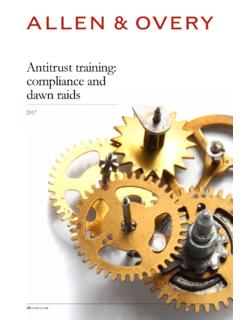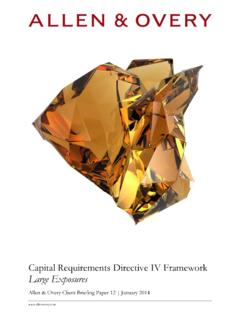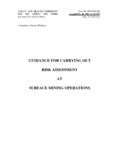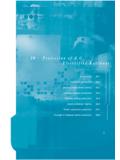Transcription of Capital Requirements Directive IV Framework …
1 Capital Requirements Directive IV Framework unfunded Credit Risk Mitigation in the Banking Book: Guarantees and Credit Derivatives Allen & Overy Client Briefing Paper 6 | January 2014 2 CRD IV Framework : unfunded Credit Risk Mitigation in the Banking Book: Guarantees and Credit Derivatives | January 2014 Allen & Overy LLP 2014 CRD IV Framework : unfunded Credit Risk Mitigation in the Banking Book: Guarantees and Credit Derivatives This briefing paper is part of a series of briefings on the implementation of Basel III in Europe via the Capital Requirements Directive IV1 (CRD IV) and the Capital Requirements Regulation2 (CRR), replacing the Banking Consolidation Directive3 (BCD) and the Capital Adequacy The legislation is highly complex: these briefings are intended to provide a high-level overview of the architecture of the regulatory Capital and liquidity Framework and to draw attention to the legal issues likely to be relevant to the in-house lawyer.
2 This briefing is for general guidance only and does not constitute definitive advice. 1 2013/36/EU. 2 Regulation 575/2013. 3 2006/48/EU. 4 2006/49/EU. NOTE: In relation to the topics discussed in this briefing, the CRR contains a number of discretions for member states in relation to national implementation. The regime may therefore differ across member states in a number of respects. This briefing paper is based on information available as at 17 January 2014. Background and Scope Sources The recast BCD introduced a revised Framework for the recognition of credit risk mitigation (CRM), including explicit recognition of credit derivatives and guarantees as mitigants of regulatory Capital Requirements . This Framework remains largely unchanged by the introduction of CRD IV and the CRR. This briefing deals with the banking book treatment of guarantees and credit derivatives as mitigants of credit risk ie which reduce the risk weight of (and, therefore, the regulatory Capital held against) the assets covered by the guarantee or credit derivative.
3 In broad terms, this is achieved by substituting the risk weight (or in the case of the Internal Ratings Based approach (IRB Approach), the probability of default (PD) and/or loss given default (LGD)) of the protection provider for that of the underlying exposure. CRR (Regulation 575/2013): Articles 108, 160-161, 183, 192-194, 201-204, 213-217, 233-241 and 247. UK Financial Conduct Authority (FCA) Policy Statement (PS13/10) CRD IV for Investment Firms (December 2013) (the FCA Policy Statement). UK Prudential Regulation Authority (PRA) Policy Statement (PS7/13) Strengthening Capital standards: implementing CRD IV, feedback and final rules (December 2013) (the PRA Policy Statement). PRA Supervisory Statement (SS17/13) Credit risk mitigation (December 2013) (the PRA Supervisory Statement). 3 Background and Scope (continued) This briefing deals with unfunded CRM. Funded CRM (collateral) is dealt with in Client Briefing 5 (Collateral: Funded credit risk mitigation in the Banking Book).
4 For credit derivatives which tranche credit risk, the securitisation rules are also relevant see Client Briefing 7 (The Securitisation Framework ). Background and key changes Article 108 of the CRR recognises the use of eligible CRM for exposures risk-weighted under the standardised approach (the Standardised Approach) and the IRB Approach. Article 247 of the CRR recognises the use of eligible CRM in respect of securitisation positions. In order to be eligible, CRM must meet the Requirements of Chapter 4, Title II of Part 3 of the CRR. As the key provisions dealing with CRM are set out in the CRR (which is directly applicable in the UK by virtue of being a regulation), they will not be transposed into UK legislation. Key changes arising under CRR are as follows: The key change introduced by the CRR in respect of CRM (both funded and unfunded ) is a new obligation for institutions to obtain formal legal opinions in order to satisfy the existing requirement for credit protection to be legally effective and enforceable in all relevant jurisdictions.
5 It is unclear whether the historic UK practice of recognising insurance as eligible for unfunded CRM is sustainable under the CRR. Central counterparties are included as eligible providers of unfunded CRM. For corporate providers of unfunded CRM, the requirement for a minimum rating of credit quality step (CQS) 3 or above in order to be an eligible provider has been removed. Certain technical changes have been made to the calculation of the haircut for currency mismatch. Requirements The Requirements split into: eligibility conditions conditions for guarantees and credit derivatives to be eligible for CRM; recognition the effect of CRM; and haircuts the effect of mismatches on CRM. 4 CRD IV Framework : unfunded Credit Risk Mitigation in the Banking Book: Guarantees and Credit Derivatives | January 2014 Allen & Overy LLP 2014 Eligibility To be eligible, protection must be (1) a credit derivative or guarantee, (2) which is provided by an eligible protection provider, and (3) which satisfies certain preconditions to recognition.
6 Instruments eligible for unfunded CRM Only guarantees and credit derivatives (including total return swaps (TRS), credit linked notes (CLNs) to the extent of their cash funding and economically equivalent instruments) are recognised as unfunded CRM5. Strictly, insurance remains outside the scope of the CRM regime. This is not a change on the face of the legislation. However, in the UK firms have sought to recognise credit insurance as unfunded CRM in certain circumstances, following guidance from the Financial Services Authority (FSA) that insurance may be eligible6 (which in turn reflected guidance provided by the Basel Committee on Banking Supervision (BCBS) as part of the quantitative impact study (QIS) on Basel II implementation). The guidance has not been adopted by the PRA or FCA. Given the CRR is maximum harmonisation, and does not include insurance as eligible unfunded CRM, it is unclear whether this treatment is sustainable following CRR implementation.
7 However, firms on the IRB Approach (see below) may be able to recognise benefits from insurance in respect of exposures by reason of a lowering of the LGD in respect of insured exposures7. Insurance may also be used to mitigate the operational risk charge. Who may provide guarantees and credit derivatives? The following are eligible to provide credit protection8: 5 Articles 203 and 204 CRR. 6 See 7 We have been advised by a UK IRB bank that this is its internal approach. 8 Article 201 CRR. sovereign entities, regional governments and local authorities, public sector entities (PSEs), banks (including multilateral development banks (MDBs)), certain international organisations, central counterparties and investment firms; and other rated entities9. The Basel Accord continues to state that special purpose vehicles (SPVs) may not provide protection under guarantees or credit derivatives unless the guarantee or credit derivative is funded or collateralised.
8 This is not reflected in the CRR, but is expected to remain regulatory policy. Preconditions to recognition (all approaches) The preconditions to recognition of guarantees comprise certain Requirements which are common to both guarantees and credit derivatives ((a) below), additional Requirements specific to guarantees ((b) below) and additional Requirements specific to credit derivatives ((c) below). (a) Preconditions to recognition of guarantees and credit derivatives Articles 194 and 213 of the CRR set out certain operational Requirements applicable to the recognition of CRM. These include Requirements (in summary) that: the protection provider be eligible; the guarantee or credit derivative be legally effective and enforceable in all relevant jurisdictions; and the firm has systems in place to manage potential concentration of risk arising from the use of guarantees and credit derivatives. Legal certainty An institution must not recognise credit protection as eligible until it has conducted sufficient legal review confirming that the credit protection 9 For IRB firms acting as guarantors, an internal (rather than external credit rating) is sufficient see Article 201(2) CRR.
9 In addition, there are additional conditions to allowing insurance companies and export credit agencies with an internal rating of CQS 3 to be eligible for the treatment set out in Article 153(3) CRR see Article 202 CRR. 5 arrangements are legally effective and enforceable in all relevant jurisdictions10. Article 194(1) of the CRR introduces a new requirement for an institution to provide, upon request of the competent authority, the most recent version of the independent, written and reasoned legal opinion or opinions that it used to establish whether its credit protection arrangement or arrangements meet the [legally effective and enforceable] condition . In light of amendments introduced by the CRR, and the European Banking Authority (EBA) s guidance in this respect in its Single Rulebook Q&A11, it appears that institutions must now obtain legal opinions in order to satisfy the CRR requirement for credit protection to be legally effective and enforceable in all relevant jurisdictions12.
10 The EBA indicates that, as long as it is independent, written and reasoned , an opinion may be provided by an internal legal counsel (rather than external legal counsel), however, internal legal counsel appetite for this role and market practice in this respect is yet to be established. Market practice also remains to be established as to the extent to which generic opinions for particular types of transactions as opposed to transaction-specific opinions will be relied upon. The EBA guidance indicates that where an institution engages in the same type of transaction, with counterparties located in the same jurisdiction and uses the same CRM technique , it can rely on the same opinion (eg a generic opinion relating to a master netting agreement covering all relevant jurisdictions). Further Requirements apply to firms that adopt the IRB Approach (IRB firms)13. These include formal Requirements that any guarantee or single-name credit derivative be evidenced in writing, is non-cancellable on the part of the protection provider, is in force until the obligation is satisfied in full (to extent of the amount and tenor of the guarantee or credit derivative), and is legally enforceable against the protection provider in a jurisdiction where the protection provider has assets to attach and enforce a judgement14.
